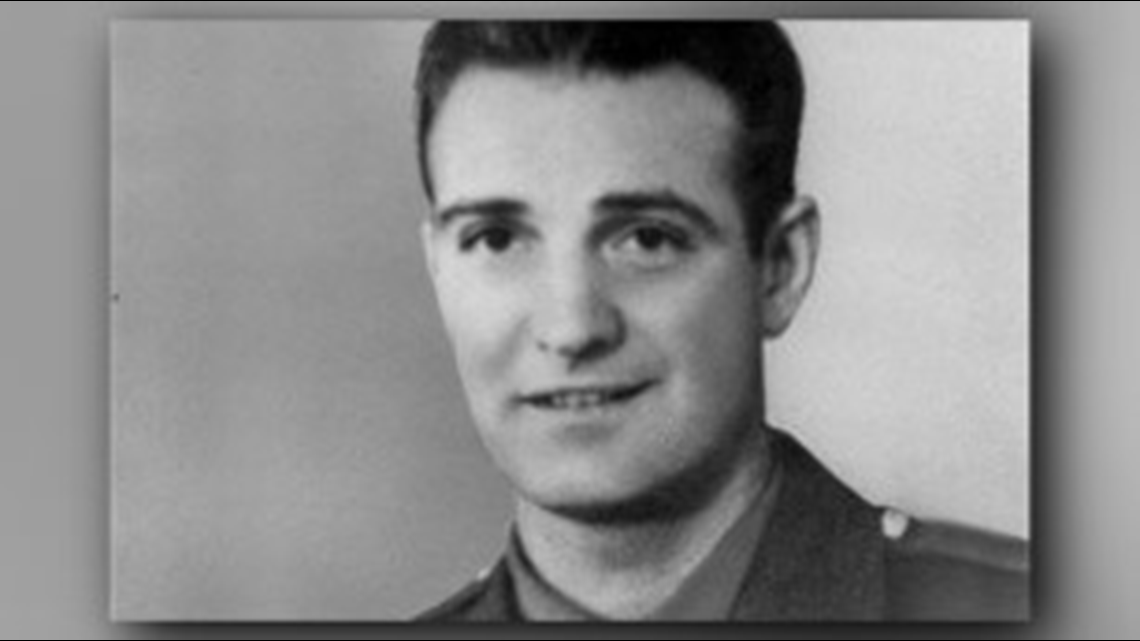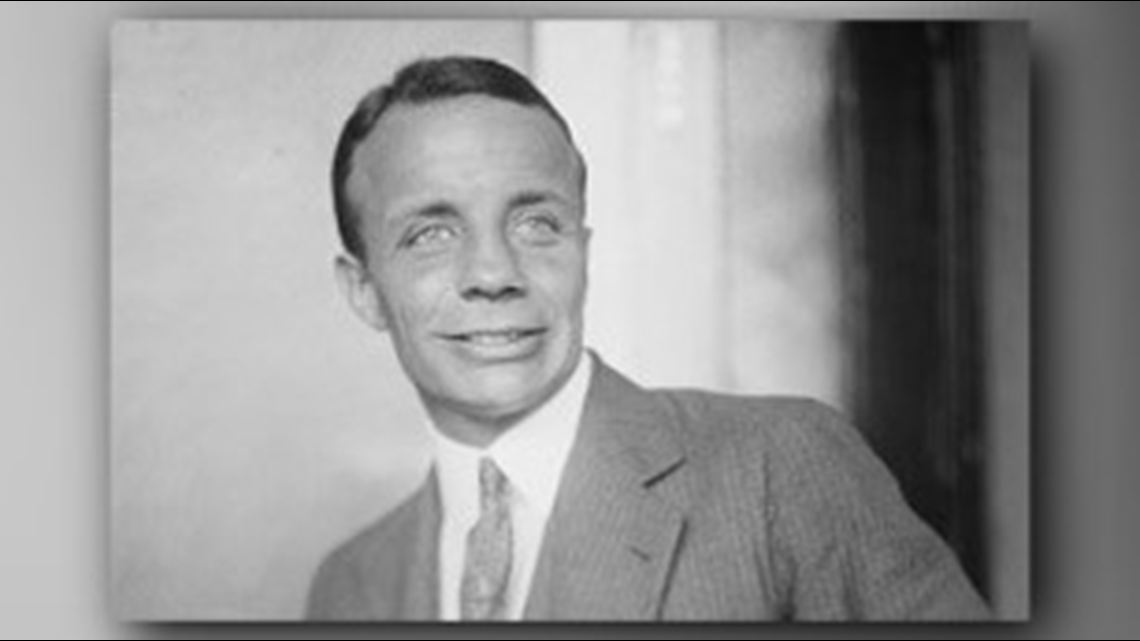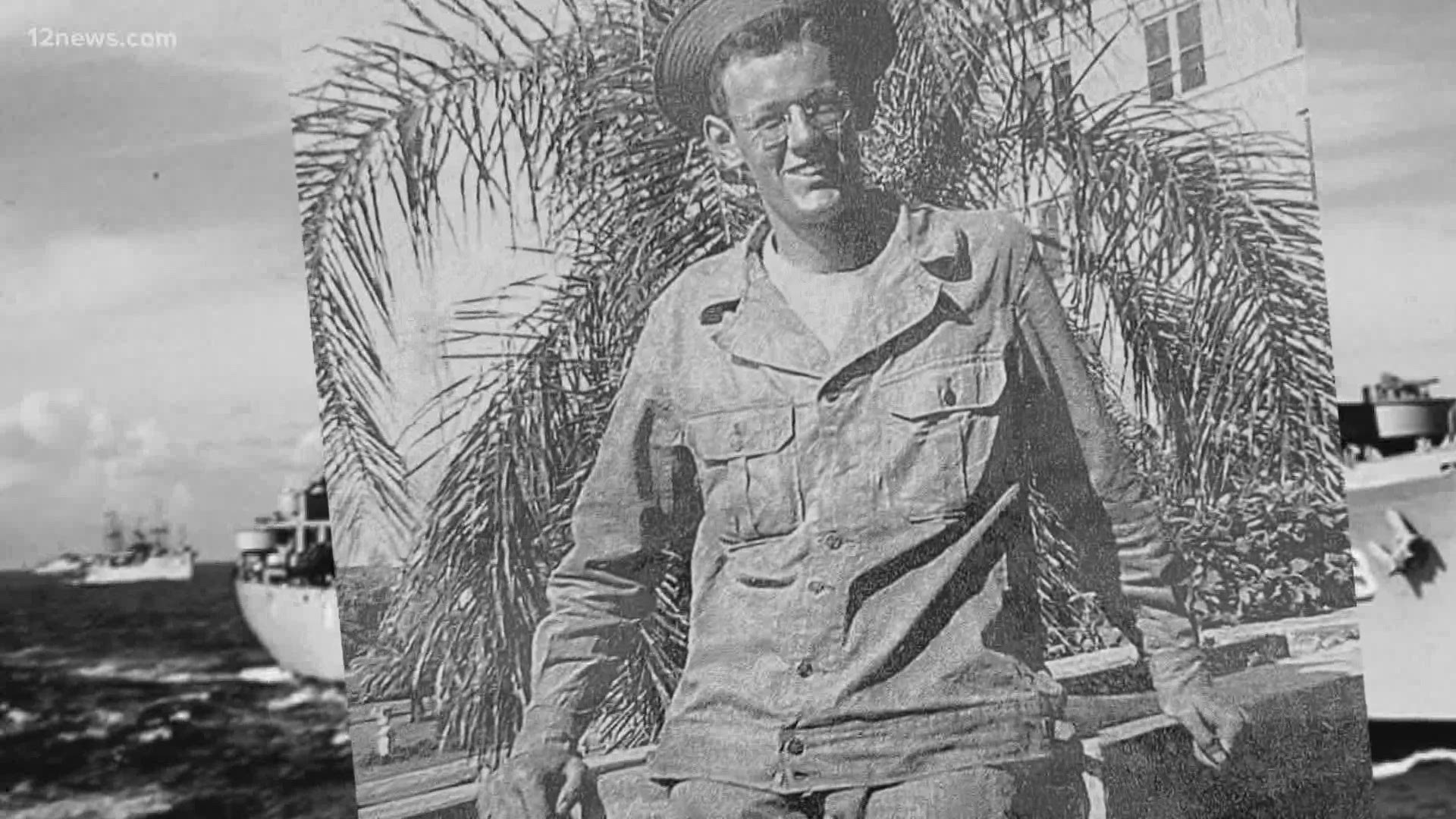ARLINGTON, Va. — On June 6, 1944, more than 160,000 Allied troops landed along a 50-mile stretch of French coastline to fight Nazi Germany on the beaches of Normandy, France.
According to the U.S. Army, General Dwight D. Eisenhower called the operation a crusade in which, “we will accept nothing less than full victory.”
More than 5,000 ships and 13,000 aircraft supported the D-Day invasion, and by day’s end, the Allies gained a hold in Continental Europe. More than 9,000 Allied Soldiers were killed or wounded, but their sacrifice allowed more than 100,000 soldiers to begin the slow, hard slog across Europe, to defeat Adolf Hitler’s troops.
CLICK HERE to listen to Gen. Eisenhower's D-Day message.
The Normandy beaches were chosen by planners because they lay within range of air cover, and were less heavily defended than the obvious objective of the Pas de Calais, the shortest distance between Great Britain and the Continent. Airborne drops at both ends of the beachheads were to protect the flanks, as well as open up roadways to the interior. Six divisions were to land on the first day; three U.S., two British and one Canadian. Two more British and one U.S. division were to follow up after the assault division had cleared the way through the beach defenses.
Disorganization, confusion, incomplete or faulty implementation of plans characterized the initial phases of the landings. This was especially true of the airborne landings which were badly scattered, as well as the first wave units landing on the assault beaches. To their great credit, most of the troops were able to adapt to the disorganization. In the end, the Allies achieved their objective.
- AIRBORNE ASSAULT
The airborne assault into Normandy, as part of the D-Day allied invasion of Europe, was the largest use of airborne troops up to that time. Paratroopers of the U.S. 82nd and 101st Airborne Divisions, the British 6th Airborne Division, the 1st Canadian Parachute Battalion, and other attached Allied units took part in the assault. Numbering more than 13,000 men, the paratroopers were flown from bases in southern England to the Cotentin Peninsula in approximately 925 C-47 airplanes. An additional 4,000 men, consisting of glider infantry with supporting weapons, medical, and signal units were to arrive in 500 gliders later on D-Day to reinforce the paratroopers. The parachute troops were assigned what was probably the most difficult task of the initial operation - a night jump behind enemy lines five hours before the coastal landings.
To protect the invasion zone's western extremity and to facilitate the "Utah" landing force's movement into the Cotentin Peninsula, the U.S. 82nd and 101st Airborne Divisions descended on the peninsula by parachute and glider in the early hours of D-Day. The paratroopers were badly scattered. Many were injured and killed during the attack, and much of their equipment was lost, but the brave paratroopers fought fiercely, causing confusion among the German commanders and keeping the German’s troops occupied. Their efforts; hampered by harsh weather, darkness and disorganization, and initiative of resourceful Soldiers and leaders, ensured that the Utah Beach assault objectives were eventually accomplished. The British and Canadian attacks also accomplished their primary goal of securing the left flank of the invasion force.
- UTAH BEACH
Utah Beach was added to the initial invasion plan, almost as an afterthought. The allies needed a major port as soon as possible, and Utah Beach would put the U.S. VII Corps within 60 kilometers of Cherbourg at the outset. The major obstacles in this sector were not so much the beach defenses, but the flooded and rough terrain that blocked the way north.
- OMAHA BEACH
Omaha Beach linked the U.S. and British beaches. It was a critical link between the Cotentin Peninsula, also known as the Cherbourg Peninsula, and the flat plain in front of Caen. Omaha was also the most restricted and heavily defended beach. For that reason, at least one veteran U.S. Division (lst Infantry Division) was tasked to land there. The terrain was difficult. Omaha beach was unlike any of the other assault beaches in Normandy. Its crescent curve and unusual assortment of bluffs, cliffs and draws were immediately recognizable from the sea. It was the most defensible beach chosen for D-Day; in fact, many planners did not believe it a likely place for a major landing. The high ground commanded all approaches to the beach from the sea and tidal flats. Moreover, any advance made by U.S. troops from the beach would be limited to narrow passages between the bluffs. Advances directly up the steep bluffs were difficult in the extreme.
German strong points were arranged to command all the approaches and pillboxes were cited in the draws to fire east and west, thereby enfilading troops while remaining concealed from bombarding warships. These pillboxes had to be taken out by direct assault. Compounding this problem was the allied intelligence failure to identify a nearly full-strength infantry division, the 352nd, directly behind the beach. It was believed to be no further forward than St. Lo and Caumont, 20 miles inland. The V Corps was assigned to this sector. The objective was to obtain a lodgment area between Port-en-Bessin and the Vire River and ultimately push forward to St. Lo and Caumont in order to cut German communications (St. Lo was a major road junction). Allocated to the task were 1st and 29th Divisions, supported by the 5th Ranger Battalion and 5th Engineer Special Brigade.
- GOLD BEACH - JUNO BEACH
Gold Beach was the objective of the 50th Division (Northumbrian) of the British 2nd Army. Its primary task was to seize Arrolnanches (future site of a Mulberry) and drive inland to seize the road junction at Bayeux, as well as contact U.S. forces on their right and Canadians on their left. The initial opposition was fierce, but the British invasion forces broke through with relatively light casualties and were able to reach their objectives in this sector. A major factor in their success was that the British assault forces were lavishly equipped with armor and "Funnies" of the 79th Armoured Division. The "Funnies" were the specialist vehicles, armed with 290 mm mortars, and designed for tasks such as clearing obstacles or minefields and destruction of large fixed fortifications. Perhaps the most famous is the "Flail" tank, which was Sherman equipped with a large roller to which lengths of chains was attached. These tanks were designed to clear terrain to their front, and detonate mine fields and other booby traps without danger to the tanks or infantry following.
- SWORD BEACH
Sword Beach was the objective of the British 3rd Infantry Division. They were to advance inland as far as Caen, and line up with British Airborne forces east of the Orne River/Caen Canal. The Orne River bridges had been seized late at night, June 5, by a glider-borne reinforced company commanded by Maj. John Howard. As at the other beaches, British forces penetrated quite a ways inland after breaking the opposition at water's edge. Unfortunately, the objective of Caen was probably asking too much of a single infantry division, especially given the traffic jams and resistance encountered further inland. The 1st Special Service (Commando) Brigade commanded by Lord Lovat, linked up in the morning with Howard's force at Pegasus Bridge on the British left. Fierce opposition from the 21st Panzer and later the 12th SS Panzer division prevented the British from reaching Caen on the 6th. Indeed, Caen was not taken until late June.
- Private Carlton W. Barrett - 18th Infantry, 1st Infantry Division


For gallantry and intrepidity at the risk of his life above and beyond the call of duty on June 6, 1944, in the vicinity of St. Laurent-sur-Mer, France. On the morning of D-day Pvt. Barrett, landing in the face of extremely heavy enemy fire, was forced to wade ashore through neck-deep water.
Disregarding the personal danger, he returned to the surf again and again to assist his floundering comrades and save them from drowning. Refusing to remain pinned down by the intense barrage of small-arms and mortar fire poured at the landing points, Pvt. Barrett, working with fierce determination, saved many lives by carrying casualties to an evacuation boat Iying offshore.
In addition to his assigned mission as guide, he carried dispatches the length of the fire-swept beach; he assisted the wounded; he calmed the shocked; he arose as a leader in the stress of the occasion. His coolness and his dauntless daring courage while constantly risking his life during a period of many hours had an inestimable effect on his comrades and is in keeping with the highest traditions of the U.S. Army.
- First Lieutenant Jimmie W. Monteith Jr. - 16th Infantry, 1st Infantry Division


For conspicuous gallantry and intrepidity above and beyond the call of duty on June 6, 1944, near Colleville-sur-Mer, France. 1st Lt. Monteith landed with the initial assault waves on the coast of France under heavy enemy fire. Without regard to his own personal safety he continually moved up and down the beach reorganizing men for further assault. He then led the assault over a narrow protective ledge and across the flat, exposed terrain to the comparative safety of a cliff.
Retracing his steps across the field to the beach, he moved over to where two tanks were buttoned up and blind under violent enemy artillery and machine gun-fire. Completely exposed to the intense fire, 1st Lt. Monteith led the tanks on foot through a minefield and into firing positions. Under his direction several enemy positions were destroyed. He then rejoined his company and under his leadership his men captured an advantageous position on the hill.
Supervising the defense of his newly won position against repeated vicious counterattacks, he continued to ignore his own personal safety, repeatedly crossing the 200 or 300 yards of open terrain under heavy fire to strengthen links in his defensive chain. When the enemy succeeded in completely surrounding 1st Lt. Monteith and his unit and while leading the fight out of the situation, 1st Lt. Monteith was killed by enemy fire. The courage, gallantry, and intrepid leadership displayed by 1st Lt. Monteith is worthy of emulation.
- Technician Fifth Grade John J. Pinder Jr. - 16th Infantry, 1st Infantry Division


For conspicuous gallantry and intrepidity above and beyond the call of duty on June 6, 1944, near Colleville-sur-Mer, France.
On D-Day, Technician 5th Grade Pinder landed on the coast 100 yards off shore under devastating enemy machine gun and artillery fire which caused severe casualties among the boatload. Carrying a vitally important radio, he struggled towards shore in waist-deep water. Only a few yards from his craft he was hit by enemy fire and was gravely wounded. Technician 5th Grade Pinder never stopped. He made shore and delivered the radio.
Refusing to take cover afforded, or to accept medical attention for his wounds, Technician 5th Grade Pinder, though terribly weakened by loss of blood and in fierce pain, on three occasions went into the fire-swept surf to salvage communication equipment. He recovered many vital parts and equipment, including another workable radio. On the third trip he was again hit, suffering machine gun bullet wounds in the legs. Still this valiant soldier would not stop for rest or medical attention. Remaining exposed to heavy enemy fire, growing steadily weaker, he aided in establishing the vital radio communication on the beach. While so engaged this dauntless soldier was hit for the third time and killed.
The indomitable courage and personal bravery of Technician 5th Grade Pinder was a magnificent inspiration to the men with whom he served.
- Brigadier General Theodore Roosevelt Jr. - 16th Infantry, 1st Infantry Division


For gallantry and intrepidity at the risk of his life above and beyond the call of duty on June 6, 1944, in France.
After two verbal requests to accompany the leading assault elements in the Normandy invasion had been denied, Brig. Gen. Roosevelt's written request for this mission was approved and he landed with the first wave of the forces assaulting the enemy-held beaches. He repeatedly led groups from the beach, over the seawall and established them inland. His valor, courage, and presence in the very front of the attack and his complete unconcern at being under heavy fire inspired the troops to heights of enthusiasm and self-sacrifice.
Although the enemy had the beach under constant direct fire, Brig. Gen. Roosevelt moved from one locality to another, rallying men around him, directed and personally led them against the enemy. Under his seasoned, precise, calm, and unfaltering leadership, assault troops reduced beach strong points and rapidly moved inland with minimum casualties. He thus contributed substantially to the successful establishment of the beachhead in France.
WHAT DOES THE "D" IN D-DAY STAND FOR?
This is the most frequently asked question by visitors to The National WWII Museum.
Many people think they know the answer: Designated Day, Decision Day, Doomsday or even Death Day.
According to the U.S. Army, the answer, like many answers in the field of history, is not so simple.
Disagreements between military historians and etymologists about the meaning of D-Day abound.
Below are two explanations provided by The National WWII Museum.
In Stephen Ambrose’s D-Day, June 6, 1944: The Climactic Battle of World War II, he writes:
"Time magazine reported on June 12 [1944] that “as far as the U.S. Army can determine, the first use of D for Day, H for Hour was in Field Order No. 8, of the First Army, A.E.F., issued on Sept. 20, 1918, which read, ‘The First Army will attack at H-Hour on D-Day with the object of forcing the evacuation of the St. Mihiel salient.’” (p. 491)
In other words, the "D" in D-Day merely stands for Day. This coded designation was used for the day of any important invasion or military operation. For military planners (and later historians), the days before and after a D-Day were indicated using plus and minus signs: D-4 meant four days before a D-Day, while D+7 meant seven days after a D-Day.
In Paul Dickson’s War Slang, he quotes Robert Hendrickson’s Encyclopedia of Word and Phrase Origins:
"Many explanations have been given for the meaning of D-Day, June 6, 1944, the day the Allies invaded Normandy from England during World War II. The Army has said that it is “simply an alliteration, as in H-Hour.” Others say the first D in the word also stands for “day,” the term a code designation. The French maintain the D means “disembarkation,” still others say “debarkation,” and the more poetic insist D-Day is short for “day of decision.” When someone wrote to General Eisenhower in 1964 asking for an explanation, his executive assistant Brigadier General Robert Schultz answered: “General Eisenhower asked me to respond to your letter. Be advised that any amphibious operation has a ‘departed date’; therefore the shortened term ‘D-Day’ is used.” (p.146)
Brigadier General Schultz reminds us that the invasion of Normandy on June 6, 1944 was not the only D-Day of World War II. Every amphibious assault—including those in the Pacific, in North Africa, and in Sicily and Italy—had its own D-Day. The National WWII Museum’s exhibitions explore the history of the D-Day invasion of Normandy and the D-Day invasions in the Pacific.
Army.mil contributed to this report.

